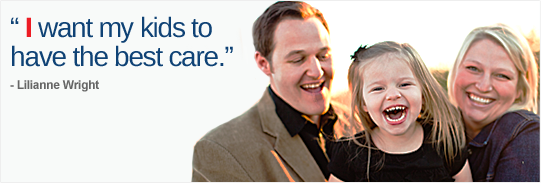Lilianne Wright


My Type-1 Diabetes Could Be Managed More Effectively with EHRs
Lilianne Wright is a mother of two from Tucson, AZ. After she survived a near-fatal diagnosis of Type-1 Diabetes in 2002, she found that one of the obstacles to managing her disease was an inaccessibility to her paper medical records. Today, her two children are benefiting from a new generation of medical tools: electronic health records (EHRs), technology she hopes her own providers will adopt. Here is Ms. Wright’s story.
In May 2002, at the age of 20, I, along with two friends, was hiking to the Waterfalls of Havasupai located in the Grand Canyon. Upon beginning our 13-mile hike back out of the canyon on the second day of our trip, I started to feel ill – an uncomfortable stomach ache and an increased thirst, two things that didn’t seem too out of the ordinary for a tired hiker who had been eating lots of packaged foods the past few days. As we hiked, I progressively grew sicker and sicker. By the time we reached the last few miles of our hike, I was rendered incapable of hiking any further by myself. I knew there would not be any other hikers along the trail who could help because it was very dark and nearly 11 p.m. I decided to call upon my Heavenly Father for help and simply said, “God, if you want me out of this canyon, I’m going to need your help.” At this time, a decision was made that one friend would carry all three packs back to the car and the other friend would stay with me and provide assistance in making my way up the steep switchbacks that led to the parking lot. Around midnight, the friend heading up to the car crossed paths with an Indian (whose job is to sit and watch the cars during the night and would otherwise not be on the trail). The Indian said he had “felt the Spirit to come on the trail,” and therefore, had saddled up his horse, come down on the trail, and subsequently, ran into my friend. When he heard that I was in trouble and needed help, he said enthusiastically, “I’ll go save her! No one dies on my watch!” I know God sent him to save my life. It was an immediate answer to my prayer.
The Indian continued down the switchbacks until he met up with my friend and me. Quickly, they hoisted me onto the horse, and we began to ascend the last steep mile of the hike. Because we were essentially in the middle of nowhere, it took another seven hours to get to the hospital after reaching the car. When I finally arrived at the emergency room, I was unconscious – my body in severe stages of diabetic ketoacidosis (DKA). When I regained consciousness a few hours later, the ICU doctor told me that had I arrived only 15 minutes later, I most likely would have died.
A Long Hospitalization, But No Medical Records
I spent the following week in the ICU as the doctors brought my insulin levels back to a normal range. From this isolated event, my initial diagnosis was Type 1 Diabetes – a disease that is autoimmune and can come out of nowhere – as it had in my case. I had many tests done to determine what might have occurred within my body while hiking, but to my recollection, the doctors were all very confused by the results of those tests. I was not a typical DKA patient, nor did my blood tests suggest I was an “undetected” diabetic that was now just witnessing itself. For the next year of my life, I grew progressively sicker and began suffering from severe and illogical symptoms of a newly diagnosed diabetic. Over the course of that year, I sought medical advice from more than 20 physicians. I had every blood test under the moon done. I had several MRIs, CT Scans, and barium studies taken. I had my gall bladder taken out. And in 2004, I had cataract surgery in both eyes – all from complications of that year of sickness.
Over that year, each new doctor I’d visit would ask if I had any medical records from the plethora of past hospital and doctor visits – to which I replied, “No. I was never able to attain them!” I’m sure many tests were repeated that year and the lack of EHRs resulted in a lot of similar wheels to be turned. I was also left to rely on my mind’s ability to recall what this or that doctor had once told me.
Still to this day, I remain a medical anomaly. Who knows what really happened in the Grand Canyon! The most likely theory is that I got infected with a rare and undetectable virus caught from the water and in my body’s rigorous defense, it destroyed my pancreas, or rather it destroyed my beta cells in the pancreas that create insulin. The extreme high blood sugar (diabetes) was the first and immediate symptom that witnessed itself that night and unfortunately, is the disease I am left with from my body’s year-long battle to heal itself.
Each time I have moved and sought out new doctors, I find myself retelling this inconclusive story. And I get the same question each time – do I have my medical records? Sadly, the response is always no. I wish I could provide a record of my crazy medical history. An additional frustration is that I have tried on several occasions to retrieve my medical records! Having these records would not only be helpful for my doctors, it would be convenient for me, too.
Today, I am blessed to be a mom of two beautiful children, Lois and Simon. Because of my disease, my pregnancies are considered high risk, and I was under the care of three different doctors through the nine months of pregnancy. During my first pregnancy, none of my doctors used EHRs, so if I visited my endocrinologist, he would have to fax the results of each visit over to my obstetrician. Unfortunately, I don’t think my obstetrician’s office ever sent corresponding information to my endocrinologist. During my second pregnancy, I noticed my obstetrician’s office was in the process of switching over to an EHR system. It was nice to have all those visits put straight into an EHR! My endocrinologist has yet to switch over.
To manage my diabetes, I use an electronic insulin pump – which serves as both my insulin delivery system and my blood glucose monitor. I can download information from it, but I still have to find a fax machine to send the data to my doctor’s office. Then I have to call the nurse to make sure this information is brought to my doctor’s attention and placed into my medical record. That’s a lot of extra steps. I wish I could send that information directly to my doctor through an EHR and know that it is safely in its correct place.
The Next Generation of Health Care: Kids and EHRs
My children’s pediatrician is a different story. He’s newer to the field and uses cutting-edge technology and EHRs. During our visits, he brings his laptop to the exam room and everything – including my kids’ measurements, temperatures, and issues discussed – go straight into their individual records. He is also able to print out a hardcopy summarization of our visit that also lists when our next immunizations and appointments are due. If I ever need an updated immunization record, I can call at any time and have it sent straight to my email instantaneously. Another thing that I love is how my children’s prescriptions are sent straight to the pharmacy electronically. There are three things that I love about this. First, the prescription is instantly sent to the pharmacy, so by the time I get there, it is filled. Time saved for a busy mom! Two, there is no room for error in translating the doctor’s handwriting, so I know that the prescription that I’m getting is the right one. And third, I don’t have to worry about losing a prescription, getting it there, and then having to pick it up later. It’s so wonderful!
I would love it if all my doctors used EHRs. As a diabetic patient, it would be very convenient and comforting to know that my total care is being coordinated among all my providers.

